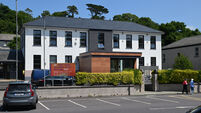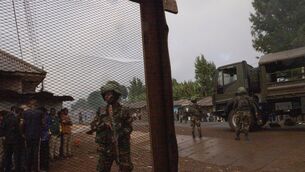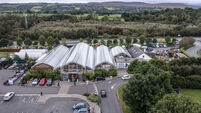Astronauts bring spacewalking robot to life
Two spacewalking astronauts attached 11ft arms to the international space station’s huge new robot today, preparing the giant machine for its handyman job on the orbital outpost.
The Canadian-built robot, named Dextre, will stand 12ft and have a mass of 3,400lbs when it is fully assembled. It is designed to assist spacewalking astronauts and possibly someday take over some of the tougher chores, like lugging around replacement parts.
The already challenging outing turned gruelling as spacewalkers Richard Linnehan and Michael Foreman struggled to release one of the robot’s arms from the transport bed where it had been latched down for launch.
Two of the bolts wouldn’t budge, even when the astronauts banged on them and yanked as hard as they could. They had to use a pry bar to get the arm out.
The other arm came out much more smoothly and quickly, paving the way for Linnehan to pull up Dextre’s body 60 degrees, like Frankenstein rising from his bed. That was the ideal position for plugging in Dextre’s gangly arms to its shoulders.
“You guys are both great working some big hurdles with trying to pry Mr Dextre out from his (transport bed) home,” astronaut Robert Behnken told the spacewalkers after they floated back inside the station.
The seven-hour overnight spacewalk came close to being drastically altered or even delayed. For nearly two days, a cable design flaw prevented NASA from getting power to Dextre, lying in pieces on its transport bed.
But Dextre got the power it needed to wake up and keep its joints and electronics from freezing when the astronauts gripped it with the space station’s mechanical arm on Friday night.
The crew hooked Dextre back up to the mechanical arm later to keep the robot warm. That will also allow NASA to perform tests to ensure power is flowing to all of its joints. They also plan to test its brakes.
Dextre – short for dextrous and pronounced like Dexter – has seven joints per arm and can pivot at the waist. Its hands, or grippers, have built-in socket wrenches, cameras and lights. Only one arm is designed to move at a time to keep the robot stable and avoid a two-arm collision. The robot has no face or legs.
Space station astronauts will be able to control Dextre, as will flight controllers on the ground. The robot will be attached at times to the end of the space station arm. It is also able to ride by itself along the space station arm’s railway.
A third spacewalk tomorrow night will provide Dextre with a tool holster. A total of five spacewalks are planned for Endeavour’s nearly two-week visit to the space station, the most ever performed during a joint shuttle-station flight.













